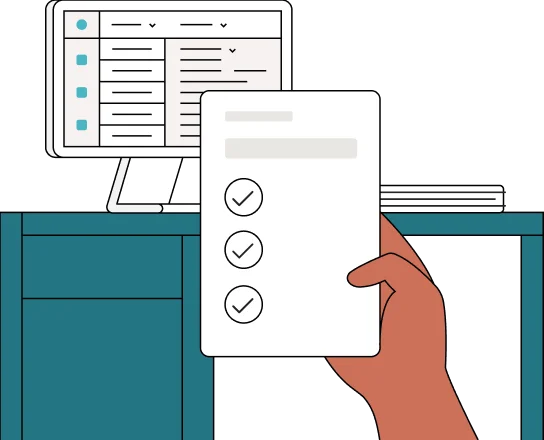The creation and maintenance of a living trust can be an effective strategy to ensure a smooth transition of your assets to your beneficiaries. Whether it’s real estate, financial accounts, personal property, or business interests, a living trust provides a comprehensive solution for managing your estate.
But before you start the process, it’s important to understand what’s involved in how to transfer assets to a trust. Discover the steps to take, financial and tax implications, and if hiring an estate planning attorney is right for you.

Key takeaways of a living trust
- A living trust is beneficial for avoiding probate, maintaining privacy in asset distribution, and providing long-term savings by minimizing legal and probate-related expenses.
- Assets must be carefully prepared for transfer into a living trust, requiring an inventory of assets, legal ownership changes, and coordination with financial institutions and insurers.
- Regularly reviewing and updating your living trust is crucial to ensure that it reflects current life circumstances and that asset distributions remain aligned with your intentions.
What are the benefits of a revocable living trust?
A revocable living trust is a legal mechanism that allows the transfer of assets to a trustee for management and eventual distribution to beneficiaries upon death or at a designated time. This process bypasses the often-time-consuming probate court process, thereby maintaining confidentiality in asset distribution and offering asset protection.
Although the initial expense of establishing a living trust exceeds that of creating a will, it can result in substantial long-term savings through minimizing or eliminating other costs. For example:
- Probate, including probate court fees and the cost of publishing notices
- Legal fees, like the cost of hiring an attorney and paying the executor of the will
- Appraisals, which are typically dependent on the size of the estate
- Other related expenses, like obtaining copies of documents or paying the probate bond (if the court requires it)
Investing in the establishment of a living trust can be a good move in creating a comprehensive estate plan and can help ensure the preservation of your assets’ value for your heirs.

Preparing to transfer your assets in 5 steps
Before you can enjoy the benefits of a living trust, there are necessary steps to take to prepare your assets for transfer.
Step 1: Create your living trust
To create your trust, you should consider speaking with a local estate planning attorney, as the necessary paperwork may vary depending on the state in which you live, and the complexity of the process increases with the complexity and size of your estate. LegalZoom offers comprehensive legal services for creating a living trust, where an attorney can assist with document preparation, transferring titles, and ensuring that your trust is formed correctly.
As part of this process, you’ll need to name a primary and successor trustee. The primary trustee is typically the individual who creates the trust, and the successor is the person who will manage the trust and distribute its assets if the primary trustee can no longer do so.
Step 2: Inventory your assets
Before beginning the process of transferring assets into a living trust, it’s vital to compile a detailed inventory of all assets intended for the living trust to avoid any oversights during the transition. Your assets generally fall into four primary types:
- Real property
- Cash accounts
- Financial instruments
- Tangible personal property
To transfer ownership of these assets, there needs to be a change in legal ownership from your own name to the trust’s name, effectively funding the trust.
Step 3: Gather titles and deeds
For all titled assets you’d like to transfer—such as real estate properties—gather all relevant documents that prove your legal ownership (like deeds, tax documents, proof of purchase, etc.).
Step 4: Change titles and deeds
Prepare new deeds to legally transfer ownership of the property assets to the trust, then file the deed with the appropriate agency. Depending on the type of property, you may need to get the deed notarized.
Step 5: Update beneficiary information
Beneficiaries are the individuals (or organizations, like charities) who will inherit the assets from the living trust. In addition to naming beneficiaries, you’ll also need to explicitly state how the assets will be distributed and to whom.

Transferring real estate into your living trust
Moving real estate into your living trust is an integral part of the asset transfer process. This can be accomplished through the use of a deed, such as a quitclaim or warranty deed, which should be executed and recorded properly. Moreover, consulting with the mortgage lender and title insurance company to verify the accuracy of the deed transfer is vital.
Prepare and execute a deed
The process of transferring real estate to a living trust begins with getting deed paperwork in order. First, locate the current property deed, prepare a new deed, get the new deed notarized, and submit the new deed to the relevant county recorder's office for filing (this should be the county in which the real estate is located, not necessarily the one where you live). Filing a deed may incur fees; check with an attorney or the county agency for specific information. Also, filing a new deed can be complicated, so you should consider talking to an attorney.
If the property is part of a homeowners' association, you may also need to obtain permission for the transfer from the respective parties.
Coordinate with your mortgage lender
If there’s a mortgage on the property, coordinating with your mortgage lender is an important component of transferring real estate to a living trust. Although uncommon, failing to inform a mortgage lender about transferring real estate into a living trust could potentially activate the acceleration clause (also called a due-on-sale clause), which means that the lender could demand immediate repayment of the mortgage, because legal ownership of the property is changing hands.
Reach out to your mortgage lender before putting property in a trust to ensure that you understand how the process will work and the financial implications.

Talk with your insurance company
Reach out to your insurance agent or broker, who will guide you through the process and provide any required documentation or information related to transferring ownership of coverage.
A common question about transferring real estate into a living trust is if doing so triggers a coverage reassessment. Generally, the property won’t need to be reassessed, as the primary trustee is still considered the owner, and so this process should not impact your insurance policy coverage. Additionally, it’s crucial to add the trust as an “additional insured” on the policy to ensure continued protection for the property.
While you don’t need a lawyer for help with putting property in a trust, hiring a real estate attorney can be beneficial for ensuring that nothing is overlooked and maintaining compliance with state and local regulations.

How to put your house in a trust
Putting a house in a trust is similar to that of putting any real estate property in a trust. First, you’ll need to prepare a new deed and get it notarized, notify your mortgage lender, and talk with your insurance company about transferring coverage. But there are some specific considerations to take into account when putting your primary residence into a trust:
- Less financing flexibility. Some mortgage lenders may not allow homes in trusts to be refinanced, or the process to do so may be more complex than for homes not in trusts.
- You’re responsible for the loan. You as the owner are still responsible for paying down the mortgage, even if the deed is no longer in your name.
Some people may choose to set up qualified personal residence trusts (QPRTs) instead of putting their house in a living trust. A QPRT is a type of grantor trust that is also considered an irrevocable trust (meaning that it can’t be altered), where the trustee can live in the home and retain an interest until the trust expires. This retained interest can reduce the trustee’s financial burden because the gift tax owed at the end of the QPRT is only dependent on the home’s value at the time of setting up the trust.
Transferring your home into a trust can have many benefits, but it’s a decision that can have major financial implications if not done appropriately. It’s best to speak with an attorney if you’re not very familiar with how to put your house in a trust, or at least have one review your trust documents before you file them.

How to assign financial accounts to a trust
Assigning financial accounts to a trust constitutes another vital step in the process of transferring assets to a living trust. This includes:
- Bank accounts
- Brokerage accounts
- Other financial instruments, like CDs
Bank accounts and brokerage accounts
Financial assets such as investments, bank accounts, money market accounts, or stock certificates can indeed be transferred to a living trust. This process involves reaching out to the relevant financial institutions, filling out any necessary paperwork, and providing copies of trust documents if requested.
For instance, transferring bank accounts to a living trust involves either closing the current account and reopening a new one in the name of the trust or, in the case of CDs (certificates of deposit), waiting for them to mature and using the funds to open a new CD in the trust’s account. Transferring a safe-deposit box to a living trust can typically be accomplished without needing to close and reopen the box.
Retirement accounts
Retirement accounts have specific rules and restrictions when it comes to being transferred into living trusts. Transfers of individual retirement accounts may be treated as distributions by the IRS, potentially resulting in income tax obligations on the transferred amount. Therefore, it is generally not recommended to transfer retirement accounts—such as 401(k), IRA, 403(b), and certain qualified annuities—directly into a living trust.
The process of transferring retirement accounts into a living trust can be complex and may not be suitable in certain circumstances. It’s a good idea to seek guidance from an estate planning attorney before proceeding.

Including personal property in a trust
The inclusion of personal property in your living trust is equally important as the transfer of real estate or financial accounts.
Specific items and general assignments
Learning how to put property in a trust is typically a simple process: You specifically name the items in the trust document and indicate that their ownership is being transferred to the trust. This includes categories of personal belongings, such as:
- Jewelry
- Art
- Collectibles
- Furniture
- Other tangible personal property
A “general assignment” within a living trust involves the transfer of ownership of a wide range of
personal assets into the ownership of the trust. For instance, let’s say that a grantor doesn’t have title documents for certain items, failed to be specific about which personal or financial property was included, or didn’t retitle certain items. In these cases, the general assignment document serves as a blanket directive for these assets, ensuring they are governed by the trust. This helps to avoid confusion upon the death of the grantor and perhaps bypass the probate process for those assets.
Business interests and your trust
Transferring business interests to a trust can be beneficial for a variety of reasons, including relieving your family from the responsibility of your business debts and potentially minimizing the tax liability on your estate. Nevertheless, it’s important to review relevant business documents—such as partnership agreements, operating agreements, or corporate bylaws—for guidance and transfer limitations.
The process for transferring a business name between interests varies depending on the type of business, but it typically involves following the terms of the business agreement and completing an assignment of interest to the trust. Here are some examples:
- Transferring a partnership interest to a living trust may require obtaining approval in accordance with the terms of the partnership agreement or operating agreement form.
- Transferring business interests from an LLC owner to a living trust typically involves obtaining approval from a majority of owners.
Transferring a sole proprietorship into a living trust is usually straightforward, as business assets are typically in the owner’s name, providing protection for the family from business liabilities.

Overlooked assets and uncommon considerations
Estate planning involves considering all types of assets, including those that are often overlooked or uncommon. Examples of commonly overlooked assets and less typical considerations include:
- Funeral trusts
- Sub-trusts for specific family scenarios
- Children’s trusts
- Generation-skipping trusts
When planning your estate, it’s important to consider whether to designate a trust as the primary or secondary beneficiary for accounts with beneficiary designations, such as savings accounts. This ensures that the assets within these accounts are properly managed and distributed according to the terms of the living trust.

What are the tax implications of transferring property into a trust?
Transferring property into a trust may have various tax implications, depending on the type of property.
Capital gains tax
When you transfer property into a revocable living trust, this does not trigger any capital gains taxes. Capital gains taxes are typically triggered upon sale, death, or transfer of property to another owner. But this changes if the property being transferred is your primary residence, which typically avoids capital gains tax through Section 121 exclusion (up to a certain dollar amount). This is also known as the principal residence tax exclusion.
Estate taxes
While a revocable trust is favored by many individuals due to its flexibility, this type of trust is subject to estate taxes upon death of the owner if they pass away with assets greater than a certain amount (currently about $13 million for federal estate taxes). However, you can create revocable trusts that can help reduce estate taxes upon the death of the trust owner. Assets in an irrevocable trust typically do not incur estate taxes, but they may be subject to other taxes. Similarly, QPRTs aren’t included in the value of the estate, so they aren’t subject to estate taxes.
Gift taxes
Gift tax is not triggered when you transfer assets to a revocable trust. One-time gift taxes may be due at the time of transfer for any gifts to an irrevocable trust. Estate planning attorneys can help you decide which type of trust is best for your situation, and you can review information about gift taxes on the IRS’s website.

Why you should regularly review and update your trust
Once your living trust is established and funded, the process doesn’t end there. Continually reviewing and updating your living trust is necessary to keep it current and effective, responding to life events, such as marriage, divorce, the birth of a child, the death of a beneficiary, and changing circumstances, such as shifts in your financial landscape or family dynamics. It is advisable to review your trust at least annually to accurately reflect your current situation and intentions for your estate.

FAQs
How are assets transferred to a trust?
Assets can be transferred to a trust through methods like a deed of grantor(s) to trustee(s), title transfer, assignment of ownership, opening new accounts, naming the trust as a beneficiary, and more. Putting property in a trust can be done through various legal means, providing flexibility to the grantor.
What assets should not be in a trust?
You should not put assets like retirement accounts, health savings accounts, life insurance policies, and vehicles in a trust. These types of assets generally have cash value and should not go into a living trust. Additionally, assets like vehicles shouldn’t be put in a trust because car accidents could expose the trust and its assets to lawsuits.
What are disadvantages of putting property in a trust?
Depending on the type of trust, there may be some disadvantages of transferring property, including a lack of protection for other assets from creditors (e.g., a revocable living trust does not protect assets from creditors, while an irrevocable trust does), and limited tax benefits.
Are transfers to a trust taxable?
Some transfers to a trust are taxable, depending on the type of trust. For example, there may be capital gains or gift taxes for transfers to irrevocable trusts. However, transfers to a trust are not subject to income tax, including gifts to trusts and distributions of principal from trusts to beneficiaries.
What are the benefits of a living trust?
A living trust offers benefits such as bypassing probate, maintaining privacy, providing asset protection (irrevocable trusts only), and potentially offering tax benefits. Consider setting up a living trust to take advantage of these benefits.
Brette Sember, J.D., contributed to this article.



